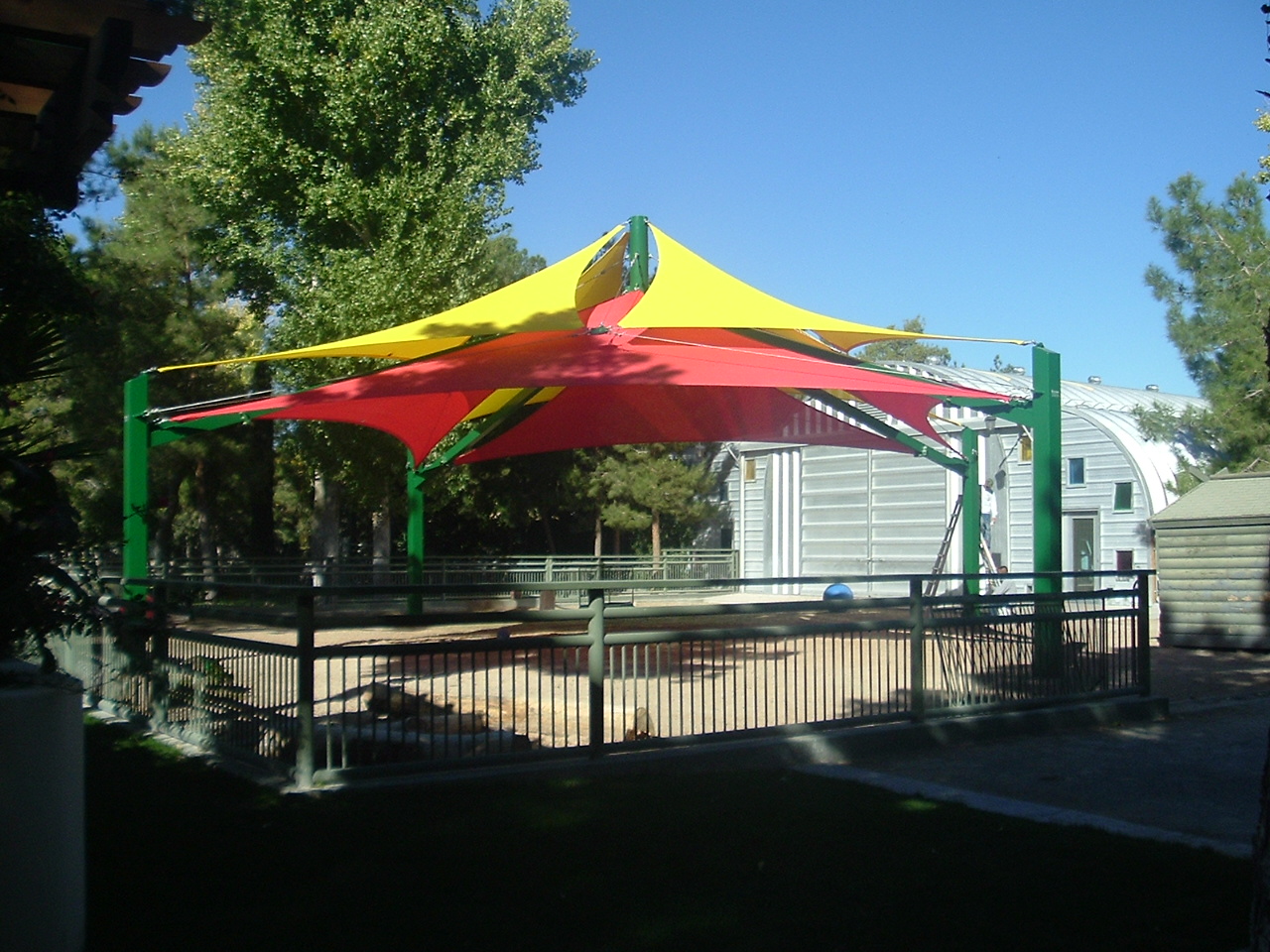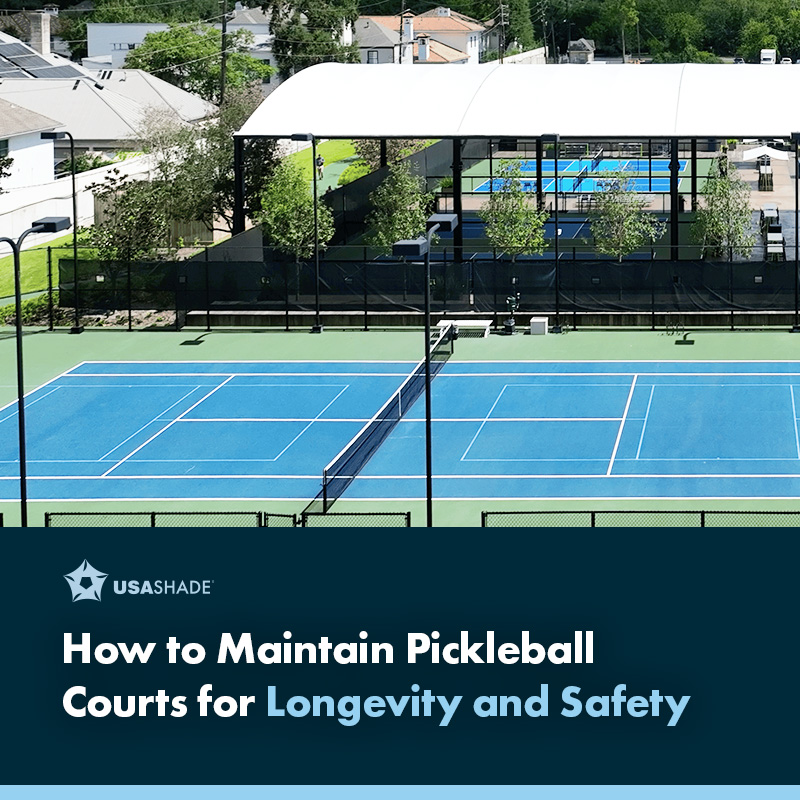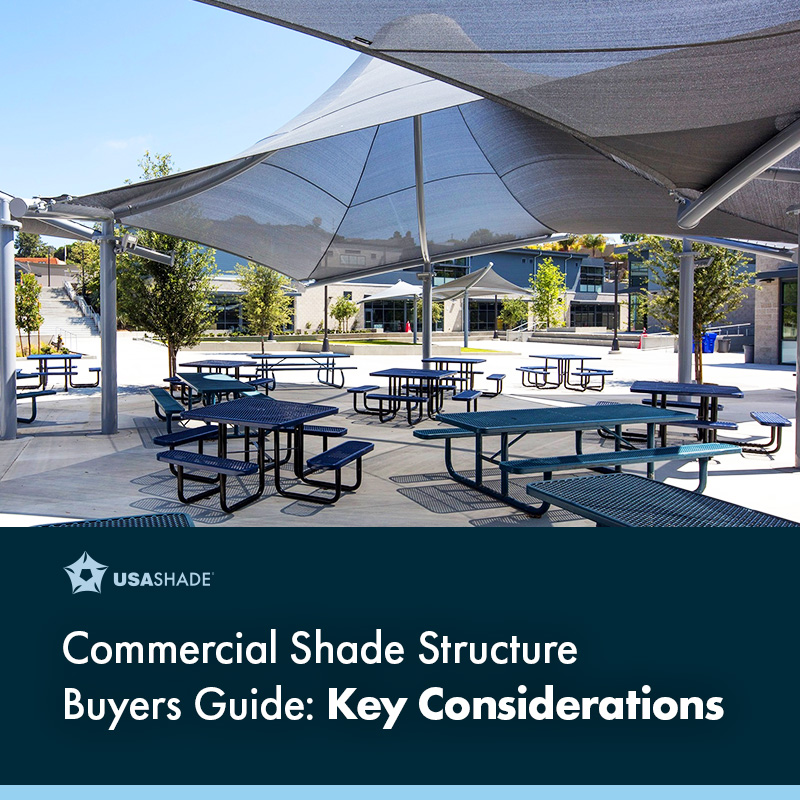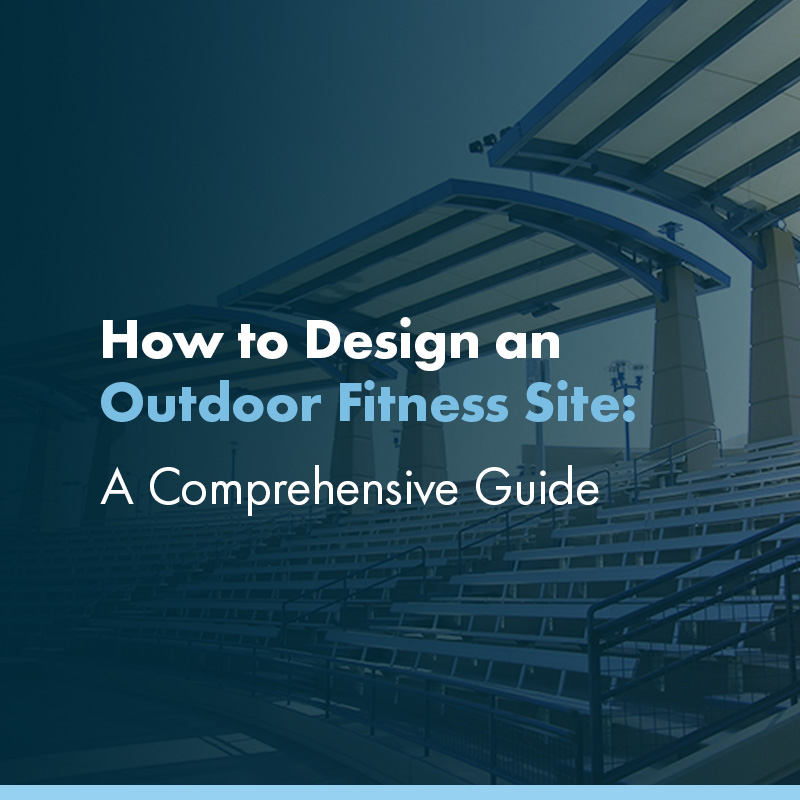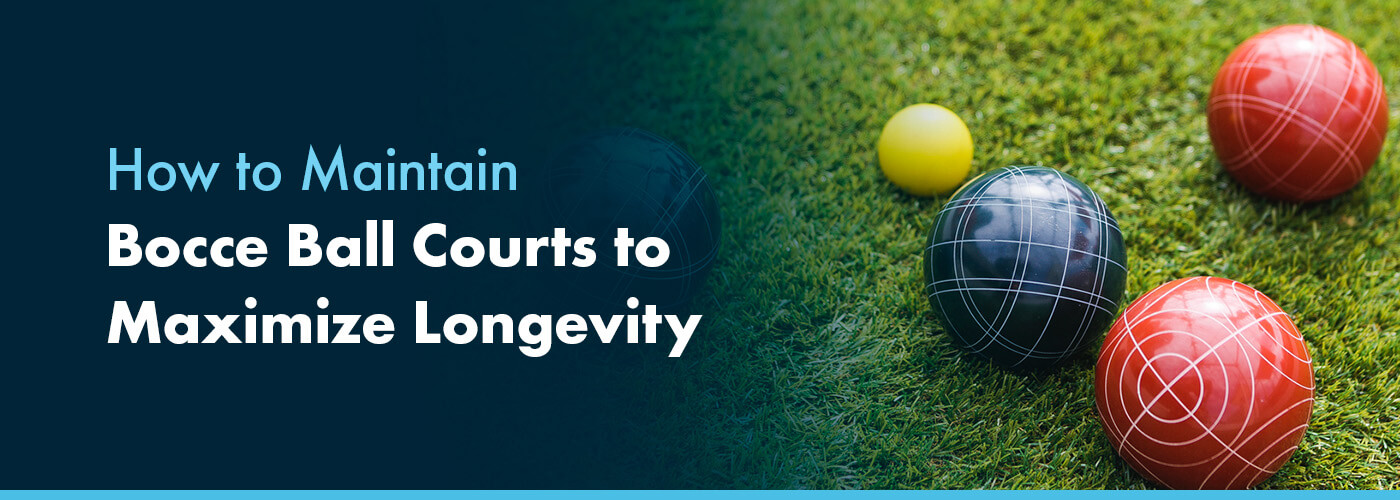
Bocce ball courts have become gathering points for friendly competition and connection across parks, community centers, schools and commercial spaces, and it’s easy to see why. Bocce ball is fun and doesn’t require much physical exertion. Anyone can learn to play, regardless of age or physical ability.
As this classic game continues to grow in popularity, properly caring for the courts where it’s played is good practice and a smart investment. Maintenance protects the surface from wear, preserves playing quality and reduces long-term repair costs. It also supports safety and keeps your facility looking professional.
This bocce court maintenance guide presents best practices that facility managers, property owners or community planners may follow, from daily care to long-term planning. It also highlights how well-designed shade structures for bocce ball courts enhance player comfort and preserve surface integrity, helping your court serve more people, more often.
Bocce Ball Court Surfaces and Their Maintenance Needs
Before exploring how to maintain your bocce ball court, it’s essential to understand the surface you’re working with. Each material offers a different balance of performance and maintenance intensity. Tailoring your care routine to your surface material will help you get the most from your court:
- Clay: This traditional option is known for its professional finish and smooth roll. Clay courts require daily watering, rolling and patching. They offer fast gameplay but demand high upkeep.
- Crushed stone or decomposed granite: Crushed stone offers natural drainage and is easier to maintain than clay. It needs periodic raking and compacting to maintain a level playing surface and resist weed growth.
- Oyster shell: Oyster shell surfaces have a distinctive look and support effective ball movement. However, they degrade over time and need regular replenishment to maintain performance.
- Synthetic turf: Modern materials like synthetic turf offer low-maintenance alternatives to organic surfaces. These courts maintain a uniform playing experience across seasons and require less daily care. However, their up-front cost is higher, and they still need brushing and infill adjustment over time.
- Poured-in-place rubber: Poured-in-place rubber offers slip resistance and comfort, making it ideal for public parks or inclusive recreation areas. Although durable, this surface needs regular specialized cleaning and occasional wear checks.
Regular Surface Maintenance
Keeping a court in optimal condition requires daily, weekly and seasonal attention.
Daily/Weekly Tasks
Leaves, twigs and small debris can alter ball movement and interfere with drainage, so it’s vital to clear the surface regularly with a soft-bristled broom, drag broom or leaf blower, depending on the specific surface. For loose-fill courts, regular sweeping redistributes surface material evenly, preventing ruts or uneven patches from forming. Use a drag broom or court rake to level high-traffic areas, especially near foul lines or end boards.

To refresh the playing surface for a new game, using tools recommended for your specific material is essential to protect the surface integrity and avoid damage. For instance, you can recondition clay surfaces using a lute or landscape rake. Synthetic turf may require a stiff brush to lift fibers and redistribute infill, while you can clean rubber courts with mild soap and water for best results.
Surface Leveling
Consistency across the court’s surface is one of the defining features of a well-maintained facility. Even minor unevenness can affect ball roll and disrupt the game. For that reason, checking the court with a straight edge or level is an integral part of the bocce ball court maintenance routine, especially after rainfall or frequent use.
For oyster shell and crushed stone courts, you can correct low spots by redistributing surface material with a rake. Applying a thin layer of new material followed by compaction may be necessary when dealing with deeper depressions in clay courts. Proper leveling reduces pooling and supports fair, enjoyable play.
Moisture Management
Moisture is a critical factor in maintaining a bocce ball court. Too much water can lead to erosion, puddling or algae growth, while too little may cause cracking or dust that disrupts the pace of play. Proper drainage and strategic watering ensure your court stays balanced and playable.
First, assess your court’s existing drainage. Most surfaces require a slight slope to encourage water runoff. If pooling occurs, clear any clogged drains and consider adding or adjusting drainage systems. Watering is also essential for clay or crushed stone courts in dry climates or during hot seasons. Lightly water the court to keep the surface material dust-free. Avoid overwatering, as saturated surfaces can become muddy.
Structural Maintenance
Beyond surface care, the long-term stability of a bocce facility relies on consistent attention to its borders, edging and drainage systems. These elements frame the court and prevent water damage. You can avoid costly repairs and protect your overall investment by incorporating structural checks into your bocce court maintenance routine.
Border and Edging Care
Borders and edging define the playing area and allow for accurate bank shots. Well-maintained edging prevents erosion and material loss for natural surfaces like clay or crushed stone. Synthetic turf and rubber courts also rely on secure edging to stop surface lifting or curling, which can interfere with play. Wood, synthetic panels or concrete are common edging choices, and each requires a different care approach:
- Wooden borders: Check wooden borders regularly for warping, splintering or rot. Sanding and sealing can extend their life span, while total replacement may eventually be necessary.
- Concrete edging: Concrete edging is more durable but susceptible to cracks. Inspect for minor fractures and repair them early with sealant to prevent structural compromise.
- Synthetic edging: While low-maintenance, synthetic edging can fade or become brittle with prolonged sun exposure. Replacement may be necessary after several years of heavy use.
Drainage System Upkeep
Even the best-kept surface materials will deteriorate without proper water management. Drainage components, such as French drains, perforated pipes, sloped base layers or grated inlets, need frequent inspection for clogs or sediment buildup. After storms, walk the perimeter to check for slow drainage, which may indicate clogged lines or grading issues. Clear out leaves, sediment or other blockages to maintain proper flow.
Shade Structures and Protection
Whether hosting league matches or casual games, incorporating bocce ball court shade structures elevates the overall experience and safeguards your investment.
Benefits of Shade Structures
Adding shade structures for bocce ball courts provides numerous advantages:
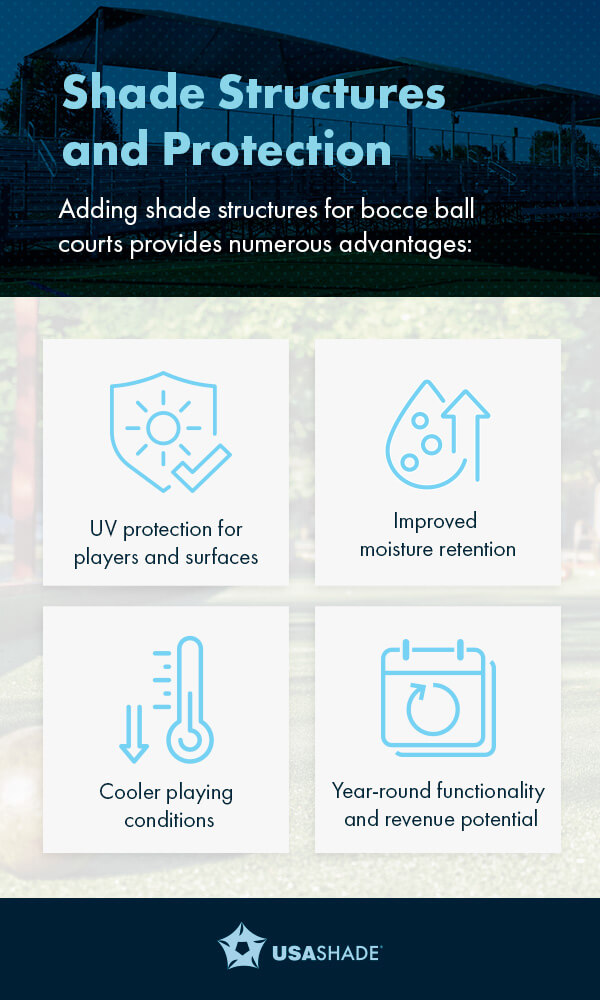
- UV protection for players and surfaces: Shade structures shield players from intense sun exposure during peak hours, reducing health risks and fatigue while preserving the surface underneath. For courts surfaced with synthetic turf or poured-in-place rubber, shade reduces fading and extends the usable life of the material.
- Improved moisture retention: Shaded areas retain moisture longer on crushed stone and clay courts. Better moisture retention means less frequent watering and a more stable surface throughout the day, particularly in arid regions.
- Cooler playing conditions: Shade can reduce surface and ambient temperatures by several degrees. Cooler conditions allow longer playing sessions, improve user comfort and keep the court safer during hot weather.
- Year-round functionality and revenue potential: Shade coverage extends court usability across more months and weather conditions. From a business perspective, extended usability creates more opportunities for court bookings, tournaments and community events, turning a seasonal court into a year-round attraction.
Types of Shade Solutions
Balancing performance and aesthetics is critical when selecting shade structures for bocce ball courts. Different structure types serve different facility needs and environmental conditions:
- Cantilever structures: By supporting the canopy from one side, cantilever shade structures create clean lines of sight and unrestricted movement. They are ideal for courts where perimeter access and visibility are priorities.
- Multi-sided structures: Multi-sided designs are perfect for larger or irregularly shaped facilities. They can support multiple canopy spans and are well-suited for complexes with several courts or adjacent amenities.
- Retractable systems: Retractable canopies allow operators to open or close coverage as needed, making them perfect for mixed-use environments or venues that host daytime and evening play.
- Custom structures: For facilities looking to make a distinctive impression or address specific spatial limitations, custom shade structures offer fully tailored solutions to complement surrounding architecture.
- Fabric material options: Fabric selection is crucial to your structure’s performance and longevity. Common choices include polyvinyl chloride (PVC) for strength and flexibility, polytetrafluoroethylene (PTFE) for unmatched durability and self-cleaning properties, and Novashield®, a lightweight membrane valued for UV protection and water resistance.
Shade Structure Maintenance
Like any long-term infrastructure, shade structures benefit from periodic inspection and seasonal care:
- Regular inspections: Check for fabric wear and tension issues, and examine all hardware, welds and mounting points regularly for signs of corrosion or loosening.
- Routine cleaning: Gently clean the fabric using approved nonabrasive agents to remove dust, pollen, debris and coastal salt. Frequent cleaning prevents staining and material degradation, especially in high-UV or coastal environments.
- Seasonal checks: Schedule detailed assessments before summer heat or after winter storms. Inspect tension cables, tighten fittings, examine surface coatings and document findings to spot patterns over time.
Seasonal Maintenance
Adjusting your bocce court maintenance to reflect seasonal weather patterns minimizes long-term repair costs. Whether your court features synthetic turf, clay, crushed stone or rubber, seasonal upkeep keeps it in prime condition year-round.
Spring Preparation
As courts transition out of winter, conduct a thorough inspection. Look for frost heave, low areas, surface cracks or water damage. Clay and crushed stone courts may need fresh topdressing to restore level play, while synthetic turf benefits from a deep cleaning to remove debris built up over the colder months. You can also check drainage systems to confirm water is flowing freely.
Summer Care
High temperatures can quickly stress surfaces. Clay and oyster shell courts require consistent misting or watering to prevent cracking and dust buildup in the summer. Synthetic turf retains heat and requires proper shading to help regulate temperature and protect players. Monitoring surface moisture and rolling courts periodically helps maintain smooth gameplay throughout peak season.
Fall Maintenance
Falling leaves and organic matter can clog drains and alter ball roll during fall. Regular sweeping or blowing is critical, especially for oyster shell and crushed stone courts. As the season winds down, apply protective measures such as resurfacing low spots and tightening edging.
Winter Protection
Although bocce courts are not always in use during winter, they still require care to prevent off-season damage. Cover clay courts with breathable tarps to reduce freeze-thaw damage. Turf and poured-in-place rubber courts require periodic checks for pooling water or frost heave. It’s also critical to clear drainage components before snowfall to protect your court for the next season.
Professional Maintenance Services
While you can handle most maintenance tasks in-house, there are times when professional support is a wise choice, especially for more complex or heavily used bocce ball facilities.
When to Seek Professional Help

Experts with specialized equipment and experience are best suited to handle specific needs, including:
- Major repairs: Structural issues like broken edging, extensive drainage failures, widespread material loss or deep surface damage may require full or partial rebuilding.
- Resurfacing projects: Clay, oyster shell and decomposed granite courts often need resurfacing every 1-3 years, depending on use and weather exposure.
- Hidden issues: Annual or biannual professional evaluations can identify developing problems that routine checks may overlook.
Choosing Maintenance Services
Selecting the right partner for professional court care is critical. A well-qualified service provider will understand the nuances of your surface type and help extend the life of your investment. When evaluating options, consider the following:
- Surface-specific expertise: A provider experienced with your court’s surface will know the correct repair techniques, resurfacing intervals, moisture management methods and other areas of concern.
- Proven track record: Ask for references and examples of completed projects.
- Long-term value vs. cost: The lowest bid is not always the most economical. A slightly higher-priced service that uses superior materials or offers comprehensive coverage often saves money over time by reducing the frequency of major resurfacing.
- Transparent pricing: Request detailed estimates that outline labor, materials and service frequency.
Preventive Measures
While structural care and seasonal upkeep are vital, thoughtful preventive strategies also help reduce wear and significantly extend the court’s usable life.
Court Rules and Guidelines
Establishing on-site expectations for play is a simple, effective way to reduce unnecessary wear and tear:
- Usage policies: Define rules for footwear, equipment and gameplay. For instance, requiring flat-soled shoes and prohibiting dragging heavy objects across the court prevents unnecessary surface damage. Clear rules regarding hours of play and maximum group size also prevent overuse and help distribute wear evenly across the surface.
- Player education: Informing players about the care requirements of each surface type creates shared responsibility for upkeep.
- Equipment guidelines: Encourage proper handling of bocce balls, rakes and brushes. Storing tools correctly and avoiding misuse preserves equipment and the court itself.
Weather Protection
Adapting your preventive care strategy to climate factors adds another layer of protection. Each weather condition presents unique risks that can be mitigated through proper planning:
- Rain management: After storms, delay play until the surface fully drains. For natural fill surfaces, rake and recompact wet areas to prevent rutting or erosion.
- Sun exposure: Position courts to minimize direct sun, or install bocce ball court shade structures to reduce surface damage and player fatigue.
- Temperature shifts: Monitor how freeze-thaw cycles affect court borders, drainage components and playing surfaces, and adjust your seasonal plan accordingly.
Learn More About Bocce Ball Facility Maintenance With USA SHADE
A well-cared-for bocce ball court is an asset that rewards its owners for decades. Proper upkeep extends the playing surface’s life span, protects investment value, minimizes costly interruptions and creates an inviting space for players and spectators. For anyone looking for complete protection, quality shade structures can elevate your court with functional and aesthetic benefits.
With over 25 years of experience, USA SHADE offers comprehensive shade solutions to protect and enhance sports facilities of all sizes. Our team specializes in custom shade structures for bocce ball courts, tailored to match your court’s functional and aesthetic requirements. Whether you’re planning a new facility or upgrading your current one, our turnkey process spanning design, engineering and installation makes it easy to get started.
Contact us today to discover how we can help protect your investment and elevate your bocce ball court with state-of-the-art shade structures.


